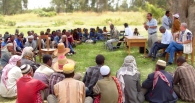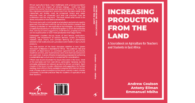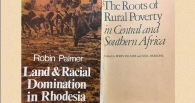Saturday is for funerals
A book review
Martin Adams
18 January 2013
/
- 0 Comments
According to the 2012 HIV/AIDS global fact sheet (www.kff.org), some 70% of those infected with HIV/AIDS live in Sub-Saharan Africa, which provides a home for some 12% of the world’s population. Further, 94% of the world’s children who have HIV are estimated to live in SSA. Swaziland with 25.9% is believed to have the highest HIV prevalence in the world. In Botswana in 2010, 24.8% of 15-49 year-olds were found to be HIV positive.
Working on land matters in Africa, I have long been aware of the negative impact of AIDS on food security and on the uncertain tenure of widows and children. But, until recently, I had not really taken sufficient time to acquaint myself with the societal and clinical impact of the pandemic. I had heard about Saturday is for funerals, yet I had not anticipated that I would find the book so completely absorbing. It had taken me two years to get round to reading the story. During several days during this past November, I did little else!
As the cover tells us, ‘In the year 2000, the World Health Organisation estimated that 85% of 15-year-olds in Botswana would eventually die of AIDS. In Saturday is for funerals we learn why that won’t happen.’ The book is the collaborative effort of Unity Dow, a former judge of the Botswana High Court, and Max Essex, Professor of Health Sciences at Harvard. Each of fifteen brief chapters starts with a sensitive account by the judge of different aspects of the disease and how it had affected the lives of her family members and work colleagues. Each chapter is then accompanied by an explanation by the professor of the particular clinical and epidemiological aspects of each case that has led to the onset of AIDS and the death or treatment and recovery of the patients involved. There are instructive chapters on aspects relating to HIV transmission (i.e. sexual, mother-to-child and by blood transfusion); on the risk of HIV and the emerging evidence of infection; on male circumcision to reduce the risk of infection; on the testing and diagnosis of HIV/AIDS; on associated symptoms; on the availability of treatment and resistance to drugs; and on the fate of orphans and other dependants. Throughout the story is interwoven the appealing cultural landscape of Botswana.
The final chapter – Government Action Makes a Difference: A Nation Responds – describes what government and donors have done since 1996 to reduce fatalities and restore AIDS sufferers through drug therapy. Recent data offer promising signs that the national HIV/AIDS incidence (i.e. the rate of new infections per year) is declining in Botswana and to a lesser extent in countries in the region. But even in Botswana, in the continuing absence of an effective vaccine, current rates of incidence will continue to increase the overall number infected. Even if death rates are reduced by 70-80% through effective treatment with ARVs, the rate of new infections would have to decrease by the same amount for HIV/AIDS prevalence just to stay even.
You must be logged in to post a comment.



